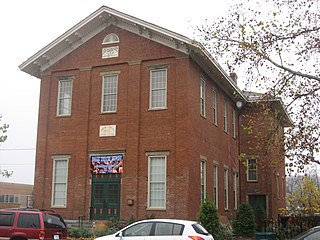
The Spencer Township Hall is a historic former government building in the Columbia-Tusculum neighborhood of Cincinnati, Ohio, United States. One of Cincinnati's oldest extant public buildings, it has been designated a historic site because of its architecture.

The Clearwater Masonic and Grand Army of the Republic Hall is a historic building in Clearwater, Minnesota, United States, constructed in 1888. It has served as a meeting hall for both a local Grand Army of the Republic (GAR) post, and a local Masonic Lodge, with commercial space on the ground floor. It was listed on the National Register of Historic Places in 1979 under the name Clearwater Masonic Lodge–Grand Army of the Republic Hall for having local significance in the themes of architecture and social history. It was nominated for its association with the fraternal organizations of Clearwater and many other rural Wright County communities that, in the words of historian John J. Hackett, "provided leadership, direction, and contributions to the county's political, educational, patriotic, and social life."
The Czech-Slovak Protective Society (CSPS), which became the Czecho Slovakian Association, was an organization supporting the welfare of Czech and Slovak immigrants to the United States. The Czech-Slovak Protective Society started as an insurance services organization. It was once the largest Czech-American freethought fraternity in the United States.

The Farmers and Merchants Bank-Masonic Lodge a is historic commercial and fraternal building at 288 North Broadway in Booneville, Arkansas. It is a two-story structure, with Colonial Revival and Early Commercial architecture. It was listed on the National Register of Historic Places in 1993.
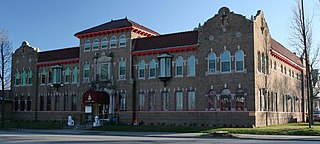
The Pythian Castle Lodge, also known as Crystal Palace, in Milwaukee, Wisconsin, United States, was built in 1927 by the Knights of Pythias, a fraternal organization. In 1988 it was listed on the National Register of Historic Places.

Washington Hall is a historic building and a registered city landmark in Seattle, Washington, that is listed on the National Register of Historic Places. It was originally built as a community center by the Danish Brotherhood in America, a fraternal organization, with meeting halls and one-room apartments for new immigrants. In 1973, the building was sold to the Sons of Haiti who leased the space to various tenants. It was purchased in 2009 by Historic Seattle and was renovated and re-opened in 2010.

Yukon, Oklahoma's original Czech Hall was built in 1899 by early Czech settlers who were members of Sokol Karel Havliček Lodge and Western Fraternal Life Association Lodge Jan Žižka No. 67. That building was replaced by the current structure in 1925.

The Czecho Slovakian Association Hall, also known as Preucil School of Music, is a building in Iowa City, Iowa that was built in 1900, as a community center and meeting place for the Czechoslovakian Protective Society (C.S.P.S.), which later became the Czecho Slovakian Association. The C.S.P.S., like other fraternal organizations, began by offering a kind of insurance. The local chapter was organized in Iowa City in 1882. It served the Czech community that was concentrated in the north and northeast areas of the city. Like other C.S.P.S. halls, it hosted social, cultural, and educational activities, and this one also hosted gymnastics.

The I.O.O.F. Hall, in Garnavillo, Iowa, also known as Garnavillo Lodge Hall, is a two-story building built in 1860. It served as a clubhouse for International Order of Odd Fellows and then later for Masons.
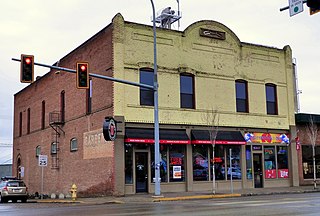
The Cheney Odd Fellows Hall in Cheney, Washington is a historic building that was built in 1904. It was listed on the National Register of Historic Places in 1990.
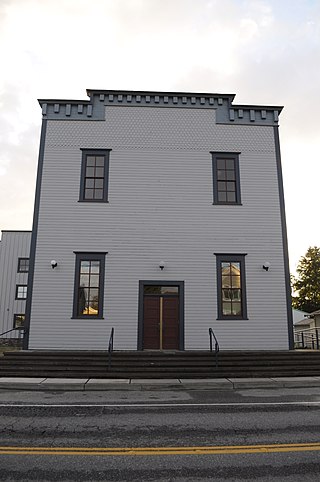
The Stanwood IOOF Public Hall, in Stanwood, Washington, is a building that was constructed in 1902. It served historically as a meeting hall. It was listed on the National Register of Historic Places in 2002.

The Western Fraternal Life Association, previously known as Zapadni Ceska Bratrska Jednota is a fraternal benefit society and financial services organization in the United States. The association has its roots in the Czechoslovak immigrant community of the 19th century. It was once the second largest Czech-American freethought fraternity in the United States.
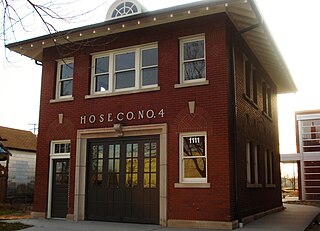
The Bohemian Commercial Historic District, also known as New Bohemia, is located in Cedar Rapids, Iowa, United States. It was listed on the National Register of Historic Places in 2002. At the time of its nomination it consisted of 75 resources, which included 48 contributing buildings, and 27 non-contributing buildings. Bohemian immigrants began settling in Cedar Rapids in the 1850s, and increasingly after the American Civil War in the 1860s and the Austro-Prussian War in 1866. They grew to be the largest ethnic group in the city, and the only one to settle in a distinct part of Cedar Rapids. They settled along the Cedar River between the downtown area and the T.M. Sinclair and Company meat packing plant. The buildings in the district were constructed between the 1880s and the 1930s. They are largely narrow-front commercial buildings and corner blocks. The buildings housed a variety of commercial establishments: a movie theater, two banks, and several filling stations. It also includes a railroad corridor factory building, a fire station, and fraternal halls. The buildings are representative of various commercial architectural styles and vernacular building forms popular at the times they were built. The Lesinger Block (1883) and the C.S.P.S. Hall (1891) are individually listed on the National Register of Historic Places.

The Western Bohemian Fraternal Union Hall is a historic clubhouse in Meadowlands Township, Minnesota, United States. It was built in 1925 as a meeting hall for a lodge of the Western Bohemian Fraternal Union, a society of Czech Americans. The hall also served as a host for Sokol gymnastics events. The hall was listed on the National Register of Historic Places in 1986 for its local significance in the themes of European ethnic heritage and social history. It was nominated for being a long-serving rural venue for the preservation of Czech American culture and heritage.
The Mizpah Lodge Building on Front St. in Sheldon, North Dakota was built in 1905. It has also been known as Mel's Country Grocery. It is a fraternal/commercial block building. It was listed on the National Register of Historic Places in 2005.
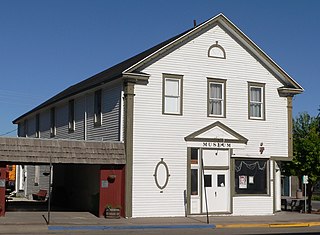
The Fraternal Hall, at 2nd and Chestnut Sts. in Kimball, Nebraska, was built in 1903–04. It includes Classical Revival architecture. It is now operated as Plains Historical Museum.

Ossian Opera House, also known as the Knights of Columbus Hall, is a historic building located in Ossian, Iowa, United States. The opera house "movement" was active in Iowa from about 1870 to 1930. Numerous auditoriums and halls were built in towns large and small. Ossian is somewhat unusual for a small town in that its opera house was a single-use type of building, rather a mixed-use facility. The frame building with a gable roof was built in 1893 by the Ossian Hall Company. It features a three-part facade, with a central frontispiece that is flanked by side wings. The hall could seat 350 people. The local Knights of Columbus council, a Catholic fraternal organization, acquired the building in 1956, and renovated the building for their clubhouse. It was listed on the National Register of Historic Places in 1979.

The Scampini Block is a historic commercial building at 289 North Main Street in the city of Barre, Vermont. Built in 1904, it is an elegant showcase of the skills of local granite carvers, and was for many years a social center for the area's large immigrant stoneworkers. It was listed on the National Register of Historic Places in 2007.

The Yondorf Block and Hall is a historic building at 758 W. North Avenue in the Lincoln Park neighborhood of Chicago, Illinois. The building was built in 1887 to serve as a meeting hall for the various social organizations in Lincoln Park; while its first floor was dedicated to retail space, it had six meeting rooms on its upper floors. Chapters of national fraternal organizations and ethnic clubs formed by immigrants in the neighborhood met in the building, and its largest hall hosted speeches and performances as well. Designed by Frederick Alschlager, the building combines Victorian Gothic and Romanesque Revival elements. While its terra cotta clad storefronts and metal cornice are typical of the former style, its use of decorative brickwork and stone is inspired by the latter.


















